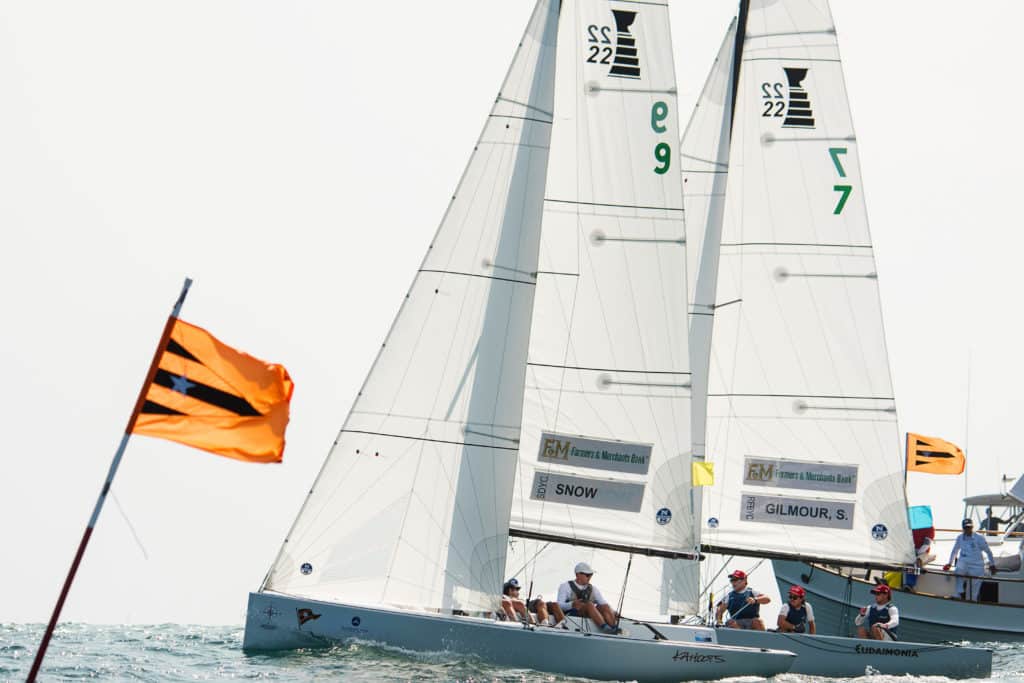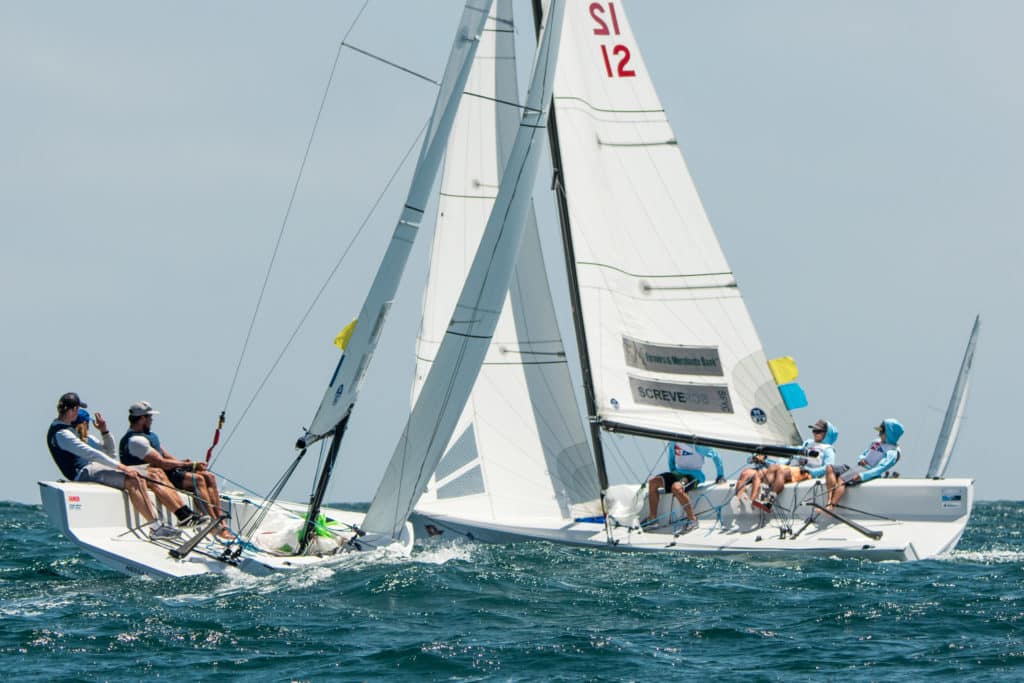
As the oldest event in youth match racing, the Governor’s Cup is revered as the most prestigious international youth match-racing regatta. It’s also the beating heart of Balboa YC, and the pride of a volunteer force that wouldn’t miss being part of it. From its location on the eastern reach of California’s Newport Harbor, Balboa YC values the “Gov Cup” as its banner in the wind. “This is the week that we live the vision,” says commodore Doug West.
Since its humble beginnings as a regional regatta — with ambitions to go national — in borrowed Cal 25s, the Governor’s Cup has become much more. Briton Paul Campbell-James is the only European winner to date (2002), but the event draws big-time from the Pacific Rim. Aussies and Kiwis have been at it with a vengeance for years. Down Under, youth match racing is hot. Six of 12 entries at the Governor’s Cup 2016 came from Australia or New Zealand. Japanese entry Ryo Leonard Takahashi, 17, had represented New Zealand in 2015, so even six is a soft number.
Elite youth match racing is a small world, however. Except for newcomer Romain Screve, who was invited as the 2016 U.S. youth match-racing champion, all the skippers and most of the crews had faced each other before. Sam Gilmour was the 2015 world champion. Fellow Aussie Will Dargaville is the reigning world champion. Another Aussie, defending Governor’s Cup champion Harry Price, had finished second to Dargaville at the worlds. Balboa YC’s own Christophe Killian had beaten San Diego’s Nevin Snow in 2015 for the U.S. Intercollegiate Match Racing title, as well as the right to represent the United States at the worlds. It goes on. Snow describes the field as a “championship of champions.”
The 2016 edition raised the age limit from under 21 to under 23, aligning with world championship standards. The 1969 and 1970 winner, Andy Rose, now a godfather of sorts to the Governor’s Cup, explains that with the under-21 cutoff, the cup was the odd man out. “We needed to get in line,” he says. “There was a time when this event was an exercise in teaching — now, not so much. The caliber is high.”
With the age shift, Snow became eligible for a shot at a second win, and Gilmour became eligible for an unprecedented third attempt. It’s no surprise that these two would meet in the finals — their final finals before they age out a second time.
One year ago, the formerly aged-out Gilmour had been on hand to coach his younger brother, Lachy. Seasoned sailors might remember their father, Peter Gilmour, Australia’s tactician in the 1987 America’s Cup. The eldest Gilmour’s legacy in match racing is larger than that, however. His aggressive use of right-of-way moves contributed to the creation of Appendix C, “Match-Racing Rules,” of the Racing Rules of Sailing, and he is the only four-time winner of the World Match Racing Tour. You say an apple doesn’t fall far from the tree? Along with being a past world youth champion, Sam Gilmour skippers M32 catamarans on the World Match Racing Tour. “Cats are their own game,” he says. “Monohull sailing relies on crew communication. At catamaran speeds, a lot falls on the skipper. The decisions have to be lightning-quick.”
Along with Will Boulden, the Gilmour brothers represented three entries from Western Australia and the Royal Freshwater Bay YC. Something’s brewing there: a strong support program through various clubs, Lachy says, “and the people who have been through the match-race programs are pushing to get our top youths into the discipline.”
Sam Gilmour adds: ”There are so many people match-racing now that it’s seen as an alternative to an Olympic campaign. Our club has six well-maintained keelboats that we can use for training any day of the week.”

That was the playing field presented to 18-year-old Screve, San Francisco YC’s 2016 U.S. youth match-racing champion, racing his first Governor’s Cup, with a new crew, only four weeks after winning the U.S. title in Sheboygan, Wisconsin. He might as well have strolled into a den of hungry lions. In Sheboygan, Sean Cornell, from New York, had fought all the way to a seven-race final, but aside from that, says Screve, there was a noticeable threshold in the skill sets. “I had an advantage because I know match racing,” he says, “but at the Governor’s Cup, everybody knows the moves. Winning at that level comes out of the gray area of doing it a little bit better in the moment.”
For the fledgling U.S. champion, there were races lost right at the finish line to (relative) old age and treachery, and there was “the big one that got away,” against Sam Gilmour. Screve nailed Gilmour in a port-starboard foul that might have determined the race, but his brother, Antoine, “couldn’t find the protest flag.” Of course, such a moment will never come up as a laugh line at a family dinner 20 years from now.
After four days of racing a double round robin, the final four were set. Balboa YC’s format, however, kept everyone sailing. The concluding races would establish a final order of finish all the way down to 12th. Snow topped the standings after losing only two races all week, and he chose to go with an all-American semifinal against Killian. That left second-place Gilmour to an all-Aussie semifinal with the defender, Price. Both matches were decided in straight races. With thick, early fog clearing to a southerly over a lumpy sea, the pressure ratcheted ever higher.
The event debuted the Governor’s Cup 22s, designed by past Balboa YC commodore Alan Andrews. As a dedicated fleet with carbon rigs and big rudders, the boats are lively, precise, and one more example of how serious people are about the Gov Cup. Most competitors raced the new boats as threesomes, but Snow went with four because the cockpit accommodates an extra set of hands.
Knowing he was the only honed match racer on his team, Snow relied primarily on fleet-race tactics. Hence the decision in Race 2 of the finals, against Gilmour, when he left the Aussies and broke left — this on a day when, up to that moment, one controlling skipper after another, including Snow, had pounded his opponent to the right to the layline. Tongues were wagging as Team Snow went off alone.
“Under the new rules — and they were in play — you always have luffing rights coming from behind,” says Snow. “We rounded the leeward mark behind Sam, but we got under him and flushed him to the right.” There was a choice to be made. Snow’s right-hand man, Scott Sinks, says: “We saw more pressure to the left. We went to the pressure.”
And it worked. As ever, if splitting tacks pays off, it goes on record as the courage of conviction. Snow won the finals, 2-0, and mentioned in his acceptance that, in their meetings, Gilmour still has a lifetime edge. Gilmour, at 22 and already adept at working an audience, declared to his hosts, “If you decide to raise the age limit again, let me know.”









